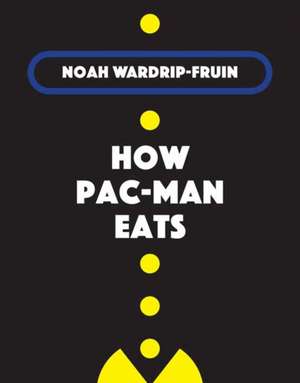How Pac-Man Eats
Autor Noah Wardrip-Fruinen Limba Engleză Hardback – 15 dec 2020
Wardrip-Fruin proposes that games work at a fundamental level on which their mechanics depend: operational logics. Games are about things because they use play to address topics; they do this through playable models (of which operational logics are the primary building blocks): larger structures used to represent what happens in a game world that relate meaningfully to a theme. Game creators can expand the expressiveness of games, Wardrip-Fruin explains, by expanding an operational logic. Pac-Man can eat, for example, because a game designer expanded the meaning of collision from hitting things to consuming them. Wardrip-Fruin describes strategies game creators use to expand what can be said through games, with examples drawn from indie games, art games, and research games that address themes ranging from border policy to gender transition. These include Papers, Please, which illustrates expansive uses of pattern matching; Prom Week, for which the game's developers created a model of social volition to enable richer relationships between characters; and Dys4ia, which demonstrates a design approach that supports game metaphors of high complexity.
Preț: 257.62 lei
Nou
Puncte Express: 386
Preț estimativ în valută:
49.30€ • 51.16$ • 41.21£
49.30€ • 51.16$ • 41.21£
Carte indisponibilă temporar
Doresc să fiu notificat când acest titlu va fi disponibil:
Se trimite...
Preluare comenzi: 021 569.72.76
Specificații
ISBN-13: 9780262044653
ISBN-10: 026204465X
Pagini: 368
Ilustrații: 80 black and white photos
Dimensiuni: 236 x 188 x 33 mm
Greutate: 0.89 kg
Editura: MIT Press Ltd
ISBN-10: 026204465X
Pagini: 368
Ilustrații: 80 black and white photos
Dimensiuni: 236 x 188 x 33 mm
Greutate: 0.89 kg
Editura: MIT Press Ltd
Notă biografică
Noah Wardrip-Fruin
Cuprins
Chapter One: Operational Logics and Playable Models
Chapter Two: Alternative Approaches
Chapter Three: Expansive Approaches
Chapter Four: Six Questions About Logics and Models
Chapter Five: Inventive Approaches
Chapter Six: Understanding Games Through Logics and Models
Chapter Seven: Inventing Graphical Logics
Chapter Eight: Refinement
Chapter Nine: Doubling
Chapter Ten: Logic Structures
Conclusion: What Games Are About
Chapter Two: Alternative Approaches
Chapter Three: Expansive Approaches
Chapter Four: Six Questions About Logics and Models
Chapter Five: Inventive Approaches
Chapter Six: Understanding Games Through Logics and Models
Chapter Seven: Inventing Graphical Logics
Chapter Eight: Refinement
Chapter Nine: Doubling
Chapter Ten: Logic Structures
Conclusion: What Games Are About
